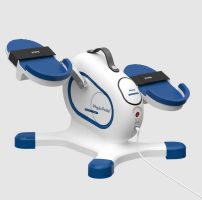 Written by Benjamin K. Mattox, DrPH, PA-C
Written by Benjamin K. Mattox, DrPH, PA-C
Stroke survivors often face challenges in regaining functionality and independence in their limbs. Rehabilitation plays a crucial role in addressing the motor impairment experienced in the upper and lower limbs after a stroke. The PhysioPedal, developed by Nobol, offers an innovative solution with its cordless, portable, motor-powered Assisted-Cycling Therapy (ACT). This therapy aims to enhance mobility, strengthen muscles, and facilitate the recovery of neural pathways and lost skills for stroke patients.
Extensive research and studies have consistently demonstrated the effectiveness of the PhysioPedal Assisted-Cycling Therapy (ACT) machine in facilitating high-repetition exercises for stroke patients. These exercises play a crucial role in stimulating neuroplasticity, the brain's remarkable ability to rewire and heal itself. By promoting neuroplasticity, the PhysioPedal assists the brain in recovering lost motor skills by forging new neural pathways. Engaging in regular high-repetition exercises with the PhysioPedal can significantly contribute to the promotion of neuroplasticity, leading to improved mobility and enhanced overall rehabilitation outcomes.
It includes two sets of pedals for hands and feet, making it an ideal solution for stroke patients who have lost mobility on one side of their body.
 | Motorized Full Body Exerciser Bike - PhysioPedal by Nobol | Ideal for Low-Impact Rehab and Fitness View Product |
Based on findings from the National Stroke Association, approximately 10 percent of stroke survivors achieve near-complete recovery, while another 25 percent experience minor impairments during their rehabilitation journey. However, for 40 percent of individuals, moderate to severe impairments necessitate specialized care that impacts their everyday functioning at both personal and professional levels. Furthermore, around 10 percent of stroke patients require long-term care in nursing homes or similar facilities, highlighting the diverse outcomes of stroke rehabilitation.
The PhysioPedal Assisted-Cycling Therapy offers stroke patients a unique and effective approach to enhance upper and lower limb rehabilitation. With its advanced features, portability, and focus on promoting neuroplasticity, the PhysioPedal empowers stroke survivors to regain mobility, strength, and overall well-being. By incorporating the PhysioPedal into rehabilitation routines, stroke patients can accelerate their recovery and improve their quality of life.

Benjamin K. Mattox, DrPH, PA-C
Orthopedic surgery physician assistant, doctor of public health, and owner of a public health consulting firm. With over a decade of Active Duty Navy Experience, Deployments with the Navy SEALS, and as a Professor for Purdue University - Dr. Mattox is a highly qualified and experienced clinician with a firm understanding of orthotic needs, rehabilitation, home access needs, gait therapy, and veteran-specific health needs.